Questionhi there. my boyfriend kept a 5 gallon "mini-bow" tank for over a year - it had a small pleco "scum sucker", 6 neon tetras and 4 zebra danios. it got a little full of algae now and then but everyone was happy. he went out and bought a 26 gallon tank, set it up, let it run a few days and moved the pleco, tetras & danios over.
the tank came with the full set up as it was a Petco deal through tetra: 2 stage power filter, lights, Tetra brand aqua safe, food and one other fish care liquid. by setting it up i mean he washed the gravel and such, put it in, put in a couple plastic plants, coral (from the pet store) and a blown glass ornament. filled it with water treated with the Aqua Safe and let it run for at least 36 hours before introducing the fishies to their new home. the whole set up is pretty bright.
the fishies were happy, he bought 2 dwarf gouramis and a couple guppies from petsmart. one guppy only lasted a day or two. "we" tested his water for ph, ammonia and nitrites with the ever-popular Freshwater Test Kit (6 formulas, color cards, 4 test tubes). ph was 7, nitrites and ammonia fine. the other guppy and the gouramis were shy, but settled in nicely.
from petsmart (i now think not so smart) he brought 2 buenos aires tetras after being told they were peaceful, and a couple little salmon colored fish with black dorsal fins, i think are tetras but i can't find a picture of them anywhere to be sure. they are very peaceful fish and keep to themselves. we also put in a black snail and a gold snail, which seem to be doing fine. the pleco sucked all the algae off the black snail and now we can see his stripes.
i tested his water sunday night and yeterday afternoon - ph has been rising and is high now - 7.8ish.
that was 5 days ago. we've lost more fish - 3 neons, 3 danios, & one of the the pink tetra like fish . we took the Buenos Aires tetras to petco last night because we saw them terrorize the other fish. everyone found a hidy hole and there they stayed. when we got home everyone was back out and swimmin along. this morning there was another dead neon and i think he said the guppy went too.
the ph is still high this morning. do you think it was stress from being terrorized or that the high ph is killing the fish (from what i've read they're all low ph fish except the gouramis which are more tolerant)? can we trust that ph down stuff? i heard bad things about it. i tried the bullseye 7.0 in a smaller, newly set up tank and it took a while (full dose every 24 hours or so) to start lowering the ph. i don't know whom to trust anymore, and the beau is now depressed (dead pets and damaged ego) and not asking questions. so i am.
HELP?
AnswerHi Cheryl;
The problem you have is "New Tank Syndrome" with too many fish to get it started. The pH fluctuating is causing the fish too much stress too. Stop using the pH adjuster and make a 25% water change every day for the next week. Fish profiles give a general idea of the ideal pH for species of fish, but all fish will adjust to what you have in your community tank with no problem. Your fish are not going to have trouble with the pH as they become used to it. It is the changing pH that stresses them. A pH that is slowly raising and/or lowering naturally to a pH we don't think is "right", is better than changing it so quickly with chemicals. Tanks and ponds fluctuate very slowly and normally over the course of 24 hours anyway. I have very rarely used pH adjusters in my tanks. Partial water changes keeps it within normal parameters, and is much healthier for the fish as well as much easier on my wallet!
You might consider taking all the new fish back to the fish store until the tank is fully broken in. The old fish are plenty to get the cycle going. All your fish are in danger if the population isn't decreased. If they won't take them back, leave them on the counter and find a new fish store. That way they can't refuse. They should have known to tell you that a new tank can't have a full population of fish so soon. They aren't worth having you as a customer if they don't know their business.
Here is my article on new tanks to tell you what's going on in there and what to do about it;
**********
New Tank Syndrome or Break-in Period
So you have a new tank and you filled it up, put the filter together, mounted the heater into place and turned on the lights. You have all the plants and decorations where you want them....
You are ready for fish.
But, your filter is not ready for a full tank of fish yet.
The filter is running and moving the water and cleaning out crud, right? Of course!
But a very important part of your filter is the part you can't see. An aquarium filter removes the larger visible stuff, but it also must remove the dissolved fish waste that turns into ammonia in the water. To do this, special bacteria must grow in the filter system and on the particles of gravel in the bottom of your tank. This process occurs even on a limited scale in little fish bowls that have no filter in them.
This is "New-Tank Syndrome" or the "Break-in Period". The entire process takes 6 to 8 weeks to complete because these "nitrifying" bacteria grow quite slowly.
Start off with only one or two hardy fish (no more than 2 total inches of fish) for every ten gallons of water and don't add more until the 6 to 8 weeks has gone by. Hard to be patient, but it is worth it to keep your fish alive and healthy. As a matter of fact, the bacteria cannot develop without fish in the tank. You can let that tank sit forever without fish in it, but as soon as the first fish goes in the process begins. Avoid changing the filter pads during break-in. This removes the bacterial colonies that are essential to a balanced aquarium. You can rinse the filter pad out in a container of aquarium water. This will preserve most of the bacteria colonies while still allowing your filter to flow freely. Even using bacteria additives and water conditioners when you first set up the tank will not make a tank cycle by itself. If there are no fish to provide food (fish waste) for the bacteria, the beneficial bacteria cultures will die and you will have to start the colonies all over again once fish are added to the tank. Once the tank has completed the initial cycle, you can change the filter pads every 4 weeks or so. But for now, just rinse them.
Feed your new fish VERY lightly. Any excess food will cause additional waste your system cannot afford to have right now. If you see food floating around or lying on the plants and gravel after five minutes, too much food is going into the tank. Cut back a little each time you feed until it is ALL gone 5 minutes after you feed them. Feed them once a day.
During this "break-in period" your tank will become cloudy and milky looking. You may have to tolerate this for the entire break-in period but it is only temporary. Changing 25% of the water three times a week until the break-in period is over helps a great deal. Changing water reduces the ammonia and nitrites that rise while the bacteria continues to multiply. If ammonia and/or nitrites become too high, your fish will become stressed and possibly die. Use a good water conditioner when you replace the water and make sure it is the right temperature to avoid shocking your fish.
When the break-in is over after 6 to 8 weeks and there are no nitrites or ammonia present in the water you can slowly add more fish. Add one or two every week until you reach the desired population. This allows the bacteria to adjust to the new population every time before adding more. Monitor the nitrites and ammonia to be sure they don't come up. If they do, make a 25% water change and check them again. Don't add the next fish until the levels are down again.
The safe maximum population for any size tank is one inch of adult fish for every gallon of water in the tank. Do some research to be sure of the fish you are interested in. Even though they are small when you buy them, you have to base your population calculations on full-sized adult fish. Many hobbyists have up to two inches per gallon but this can be risky. If a water quality issue arises or a disease occurs it will spread fast and furious in an over-populated tank. In any case, 25% water changes every week to two weeks are absolutely essential for the health of your fish.
Following these guidelines will help you get your new tank on the right track.
**********
Followups welcome
At Your Service;
Chris Robbins
Come on over and join us on the freshwater fish forum at About.com to get even more information too;
http://freshaquarium.about.com/od/questionsanswers/a/naavigateforum.htm
My member name is ChrisR62. See You There!

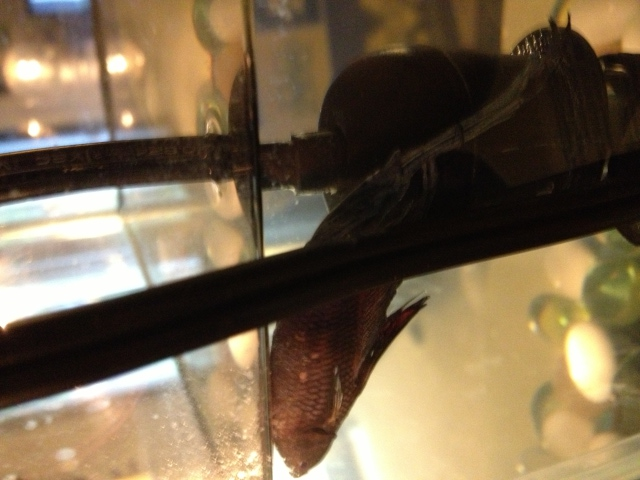 Sick betta fish
Question
Betta image 1 Betta image 2
I pur
Sick betta fish
Question
Betta image 1 Betta image 2
I pur
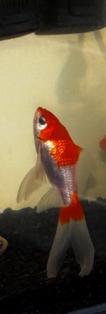 Vertical on the gravel
QuestionImage 2
Image 1
QUESTION: I dont
Vertical on the gravel
QuestionImage 2
Image 1
QUESTION: I dont
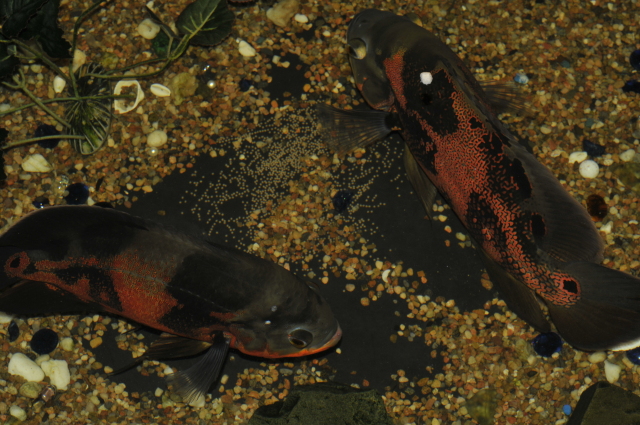 oscars breeding and egg laying
Question
Oz & Hobbs +
i have two african cichlids,
oscars breeding and egg laying
Question
Oz & Hobbs +
i have two african cichlids,
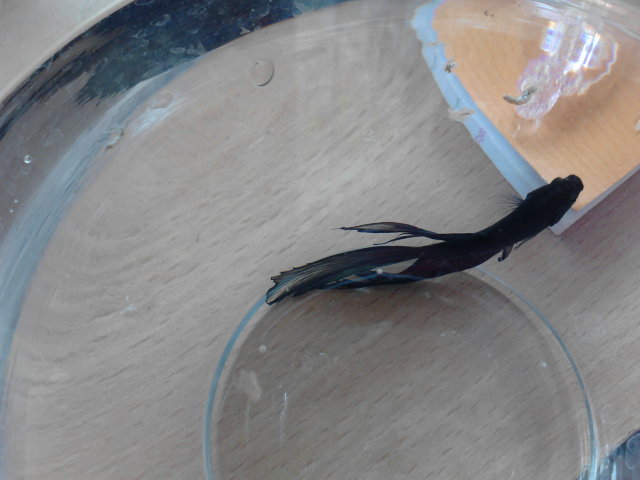 Beta Fish- dull, flits about the tank, lost appetite
QuestionBlue Beta
QUESTION: Hi Jaymie,
I read
Beta Fish- dull, flits about the tank, lost appetite
QuestionBlue Beta
QUESTION: Hi Jaymie,
I read
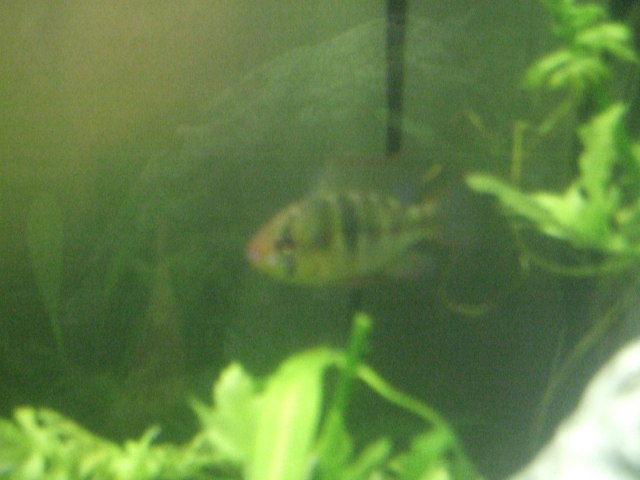 Danio fry, angles, rams
Questionram
QUESTION: HI,
I have a couple quest
Danio fry, angles, rams
Questionram
QUESTION: HI,
I have a couple quest